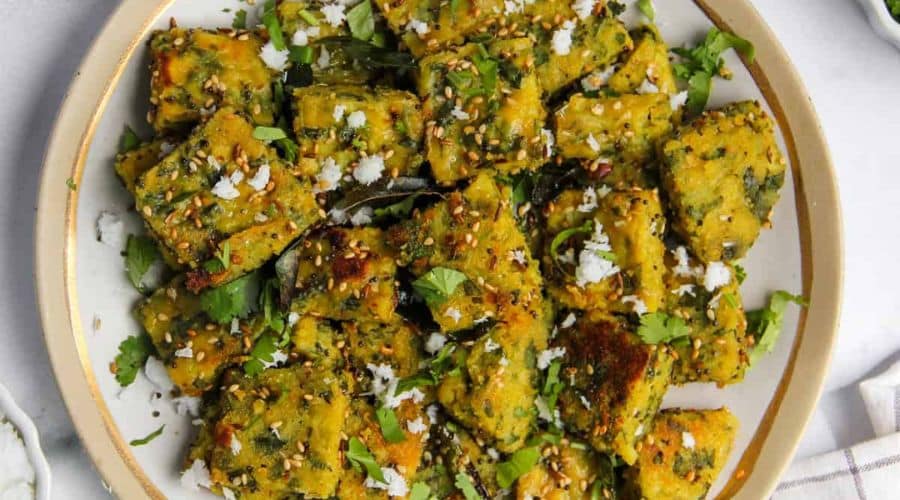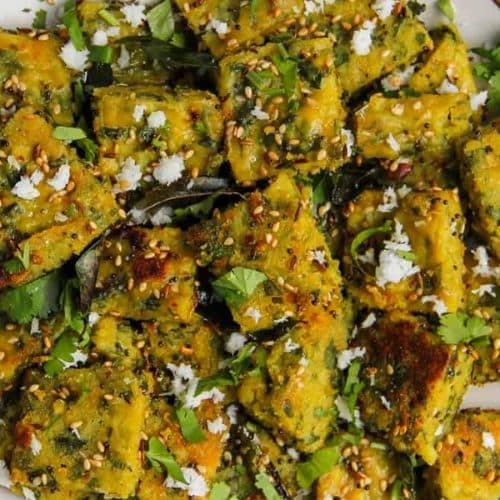All products are selected by our editorial team for quality. If you buy through our links, we may earn a small commission at no extra cost to you.
Muthiya is a beloved Indian snack, originating from the western state of Gujarat.
Known for its unique texture and health benefits, Muthiya has become a popular choice for those seeking a nutritious yet tasty treat.
Traditionally made from a mixture of flours, vegetables, and spices, this steamed delicacy is a versatile snack enjoyed at any time of day.
It serves as the perfect combination of taste and health, offering a low-calorie, fiber-rich option that’s ideal for individuals looking to maintain a balanced diet.
Whether you’re serving it with a cup of hot tea or as part of a light meal, Muthiya makes for a satisfying and wholesome snack.

What is Muthiya?
Muthiya is a steamed, dough-based snack traditionally made with flours and grated vegetables.
The name “Muthiya” comes from the word “Muthi,” meaning “fist” in Gujarati, referring to the shape of the dough being molded into a fist-like form before steaming.
While the traditional Muthiya uses a combination of wheat flour and chickpea flour (besan), variations of the recipe may include different flours like rice flour or millet flour.
The dish is made by mixing grated vegetables such as bottle gourd, carrots, and sometimes even fenugreek leaves, with a blend of spices to create a savory dough.
The dough is then steamed until it becomes firm yet tender.
The resulting Muthiya has a soft, fluffy texture with the slight crunch of the vegetables, making it an irresistible snack.
It can also be tempered with mustard seeds, curry leaves, and sesame seeds, adding extra flavor to the dish.
Health Benefits of Muthiya
Muthiya isn’t just delicious—it’s also packed with numerous health benefits, making it a guilt-free indulgence.
- High in Fiber: Muthiya is primarily made from vegetables like bottle gourd, which are high in fiber. Fiber is essential for maintaining digestive health and preventing constipation. It also helps in controlling blood sugar levels and contributes to heart health by lowering cholesterol.
- Low in Calories: Since Muthiya is steamed and not fried, it’s a low-calorie snack. This makes it an excellent choice for those looking to control their calorie intake while still enjoying a flavorful snack.
- Rich in Protein: The combination of chickpea flour and wheat flour provides a good amount of protein, which is important for muscle repair and overall bodily functions.
- Packed with Nutrients: Muthiya is made with vegetables that are rich in vitamins and minerals. For example, bottle gourd is an excellent source of Vitamin C, potassium, and antioxidants, while carrots contribute beta-carotene, an essential nutrient for eye health.
- Boosts Metabolism: The inclusion of spices like cumin, ginger, and turmeric not only enhances flavor but also helps in boosting metabolism. These spices are known for their anti-inflammatory and digestive properties.
Incorporating Muthiya into your regular diet is an easy way to enjoy a snack that supports overall health without compromising on taste.
Key Ingredients for Making Muthiya
To make authentic and delicious Muthiya, you’ll need the following key ingredients:
Flours
- Wheat Flour (Whole Wheat or Atta): This flour is the base for the dough, providing structure and texture. It’s high in fiber and adds a nutty flavor to the dish.
- Chickpea Flour (Besan): This flour adds a slight nuttiness and richness to the Muthiya, along with extra protein. It’s also gluten-free, making it a good option for those with dietary restrictions.
- Optional Alternative Flours: For a different texture or to cater to dietary needs, you can use flours like rice flour, millet flour, or a gluten-free flour blend.
Vegetables
- Bottle Gourd (Lauki): This vegetable is key to achieving the right consistency in Muthiya. It keeps the dough moist and contributes a light, fresh flavor.
- Carrots: Grated carrots add sweetness, color, and extra nutrients like beta-carotene.
- Optional Vegetables: You can add other vegetables like spinach, cabbage, or fenugreek leaves (methi) for added texture and flavor.
Spices and Seasonings
- Cumin Seeds: Cumin is a quintessential spice in Indian cuisine, giving Muthiya a warm, earthy flavor.
- Coriander Powder and Turmeric: These spices add a mild, aromatic depth and a subtle golden color to the dish.
- Red Chili Powder: Adds a touch of heat, balancing the sweetness of the vegetables.
- Ginger and Green Chilies: Fresh ginger and green chilies provide a sharp, spicy kick that enhances the flavor profile of the Muthiya.
- Salt and Sugar: To balance the flavors, a bit of salt and a pinch of sugar are added.
Other Ingredients
- Sesame Seeds: These are often used in the dough for added crunch, or they can be sprinkled on top for a nice texture and flavor.
- Oil: A little oil is used to grease the steaming tray or for tempering, contributing to the overall flavor.
- Water: Water is needed to bind the ingredients together into a dough.
These ingredients come together to create a delicious, nutritious, and flavorful Muthiya that you can enjoy at any time of the day.
Step-by-Step Recipe: How to Make Muthiya

Making Muthiya is a simple and rewarding process. Follow these easy steps to prepare this delicious snack.
Step 1: Prepare the Vegetables
Start by washing and peeling the vegetables that you’ll be using.
For the traditional Muthiya, bottle gourd (lauki) is a key ingredient.
Grate the bottle gourd using a fine grater. You don’t need to squeeze out the excess water from the bottle gourd as it helps in keeping the dough moist.
- Grate Vegetables: Grate one medium-sized bottle gourd and one small carrot. You can also use spinach or fenugreek leaves if desired.
- Set Aside: Keep the grated vegetables aside for later use.
Step 2: Make the Muthiya Dough
Now, it’s time to combine the dry ingredients and the grated vegetables.
- Mix Dry Ingredients: In a large mixing bowl, combine 1 cup of wheat flour (atta), ½ cup of chickpea flour (besan), 1 teaspoon of cumin seeds, ½ teaspoon of turmeric powder, 1 teaspoon of coriander powder, ½ teaspoon of red chili powder, and salt to taste.
- Add Grated Vegetables: Add the grated bottle gourd and carrots into the dry ingredients. Mix them well with your hands to ensure that the vegetables are evenly distributed.
- Add Spices and Water: Add finely chopped green chilies (1-2) and grated ginger (1 teaspoon) for extra flavor. Gradually add water, a little at a time, to form a soft dough. You should aim for a dough that’s soft but not sticky.
- Knead: Knead the dough for about 5-7 minutes to ensure it is smooth and pliable.
Step 3: Shape the Muthiya
Once the dough is ready, it’s time to shape the Muthiya.
- Form the Shapes: Divide the dough into small portions. Shape each portion into a cylindrical or oval shape, about the size of your finger. Traditionally, Muthiya is shaped like a fist, but you can make them however you like.
- Optional: Roll the shaped Muthiyas in some sesame seeds to give them an extra crunch and flavor.
Step 4: Steaming the Muthiya
Now, steam the shaped Muthiyas until they are perfectly cooked.
- Prepare the Steamer: Bring a large pot of water to a boil. Grease the steaming tray or plate with a little oil to prevent sticking. Place the shaped Muthiyas on the tray, leaving space between them for even steaming.
- Steam the Muthiya: Cover and steam for 15-20 minutes over medium heat. You can check the doneness by inserting a toothpick into the Muthiya; it should come out clean when they’re done.
- Cool Slightly: Once steamed, let the Muthiyas cool for a few minutes before serving or tempering.
Step 5: Tempering the Muthiya (Optional)
Tempering adds an extra layer of flavor to your Muthiya.
- Prepare the Tempering: Heat 1 tablespoon of oil in a pan. Add 1 teaspoon of mustard seeds, and once they splutter, add curry leaves (6-8), a pinch of asafoetida (hing), and a handful of sesame seeds.
- Toss Muthiya: Cut the steamed Muthiyas into bite-sized pieces and add them to the tempering. Toss them gently to coat the pieces in the spices. Cook for another 2-3 minutes until slightly crispy and aromatic.
Serving Suggestions
Muthiya is a versatile dish that can be served in various ways to suit different tastes.
Serve with Dips and Chutneys
- Green Chutney: A refreshing cilantro-mint chutney pairs perfectly with the savory taste of Muthiya. You can also serve it with tamarind chutney for a sweet-sour contrast.
- Yogurt: Muthiya goes wonderfully with a bowl of cool, plain yogurt. The yogurt balances the spices and adds creaminess to the dish.
Pairing with Tea
- Muthiya is traditionally served as an accompaniment to tea, especially in Gujarat. Pair it with a hot cup of masala chai or any tea of your choice for the perfect snack experience.
Muthiya as a Light Meal
- Muthiya can also be served as a light lunch or dinner. Serve it alongside a simple salad or a side of sautéed vegetables for a wholesome, balanced meal.
Muthiya in a Lunchbox
- This dish makes for a great lunchbox option. It’s easy to pack, nutritious, and can be enjoyed cold or at room temperature, making it perfect for school or office lunches.
Tips for Perfect Muthiya
To make sure your Muthiya turns out perfectly every time, follow these helpful tips:
1. Moisture Control in Vegetables
- Don’t Squeeze the Vegetables: Unlike some recipes where you might squeeze out excess water from grated vegetables, Muthiya requires the moisture from the bottle gourd to bind the dough. Just ensure you grate the vegetables finely, which will release enough moisture to make the dough soft.
- Dryness Check: If your dough feels too wet, add a little more flour. On the other hand, if it’s too dry, add a few more teaspoons of water to get the right consistency.
2. Consistency of the Dough
- The dough should be soft, smooth, and pliable, but not sticky. A sticky dough can make it difficult to shape the Muthiya and may lead to it falling apart during steaming. Gradually add water as needed and knead well for the perfect texture.
3. Steaming Time
- Do Not Overcrowd: Place the Muthiyas on the steaming tray with some space between each piece. This allows for even steaming and prevents them from sticking together.
- Check Doneness: Use a toothpick or a fork to check if the Muthiya is cooked. It should come out clean when inserted into the Muthiya. If it sticks, steam for a few more minutes.
4. Tempering Tips
- For an extra crispy texture, let the Muthiya sit for a couple of minutes in the tempering, so they absorb all the flavors and become slightly crisp.
- Feel free to experiment with spices in the tempering. Adding a pinch of sugar can give the Muthiya a delightful caramelized crunch.
5. Storing Leftover Muthiya
- Store Properly: If you have leftover Muthiya, store them in an airtight container in the refrigerator for up to 2-3 days. Reheat them in a steamer or microwave before serving. To keep them crispy, you can also shallow fry them in a little oil.
Conclusion
Muthiya is more than just a snack; it’s a healthy, flavorful, and versatile dish that’s perfect for any time of the day.
Whether you’re looking for a nutritious snack or a light meal, Muthiya provides the right balance of taste and health benefits.
With its combination of vegetables, spices, and steamed goodness, Muthiya stands out as a snack that’s not only satisfying but also packed with nutrients.
By following the easy-to-follow steps and using fresh ingredients, you can enjoy Muthiya at home with family and friends.
The simple yet delicious dish is sure to become a favorite in your recipe collection.
Frequently Asked Questions
1. Can I make Muthiya without using bottle gourd?
Yes, you can substitute bottle gourd with other vegetables such as zucchini, pumpkin, or spinach.
However, bottle gourd helps in keeping the Muthiya soft and moist, so you may need to adjust the water content when using other vegetables.
2. Can I make Muthiya gluten-free?
Yes, you can make Muthiya gluten-free by using a gluten-free flour blend or rice flour instead of wheat flour.
You may also need to adjust the binding and moisture content when using gluten-free flours.
3. Can I fry Muthiya instead of steaming it?
While traditional Muthiya is steamed, you can shallow fry or deep fry them for a crispy texture.
However, steaming keeps the Muthiya light and healthy, so it’s recommended if you’re looking for a lower-fat option.
4. How long does it take to steam Muthiya?
Steaming typically takes about 15-20 minutes, depending on the size of the Muthiya and the type of steamer you’re using.
Ensure the Muthiya are fully cooked by checking with a toothpick before removing them from the steamer.
5. Can Muthiya be made ahead of time?
Yes, you can make Muthiya ahead of time. After steaming, let them cool completely, then store them in the refrigerator for up to 2-3 days.
Reheat them in a steamer or microwave before serving. They can also be lightly fried for extra crispiness.

Muthiya
Equipment
- 1 Grater
- 1 Mixing Bowl
- 1 Steamer or Steaming Tray
- 1 Knife
- 1 Small Pan (for tempering)
- 1 Spatula
Ingredients
- 1 Cup Wheat Flour Atta
- ½ Cup Chickpea Flour Besan
- 1 Medium Bottle Gourd Lauki, grated
- 1 Small Carrot grated
- 2 Green Chilies chopped
- 1 Tbsp Fresh Ginger grated
- 1 Tsp Cumin Seeds
- ½ Tsp Turmeric Powder
- 1 Tsp Coriander Powder
- ½ Tsp Red Chili Powder
- As needed Salt
- ½ Tsp Sugar optional
- 1-2 Tbsp Oil for greasing & tempering
- 1 Tbsp Mustard Seeds
- 8-10 Curry Leaves
- 1-2 Tbsp Sesame Seeds
Instructions
- Prepare the Vegetables: Grate the bottle gourd and carrot. Set aside the grated vegetables without squeezing out the water from the bottle gourd.
- Mix Dry Ingredients: In a large mixing bowl, combine wheat flour, chickpea flour, cumin seeds, turmeric powder, coriander powder, red chili powder, and salt.
- Add Vegetables and Spices: Add the grated vegetables, chopped green chilies, and grated ginger to the flour mixture. Mix well.
- Form the Dough: Gradually add water to the mixture to form a soft dough. Knead for 5-7 minutes until smooth and pliable.
- Shape the Muthiya: Divide the dough into small portions and shape them into cylindrical or oval shapes. Roll them in sesame seeds if desired.
- Steam the Muthiya: Place the shaped Muthiyas in a steamer and steam for 15-20 minutes until fully cooked.
- Prepare the Tempering (Optional): In a pan, heat oil, add mustard seeds, curry leaves, and sesame seeds. Once the mustard seeds splutter, add the steamed Muthiyas and toss them gently in the tempering. Cook for 2-3 minutes.
- Serve: Allow the Muthiyas to cool for a few minutes before serving with chutney or yogurt.
Notes
- Vegetable Variations: You can add other vegetables like spinach, fenugreek leaves, or zucchini to the dough for additional flavors and textures.
- Gluten-Free Option: Substitute the wheat flour with a gluten-free flour blend or rice flour.
- Frying Option: If you prefer a crispy texture, shallow fry the steamed Muthiyas in a little oil until golden brown.
- Storage: Store leftover Muthiya in an airtight container in the refrigerator for up to 2-3 days. Reheat them in a steamer or microwave before serving.
- Serving Ideas: Muthiya can be served with a variety of chutneys such as mint chutney, tamarind chutney, or yogurt for added flavor.

